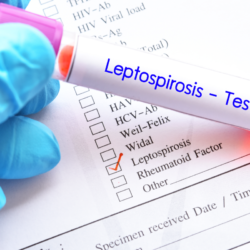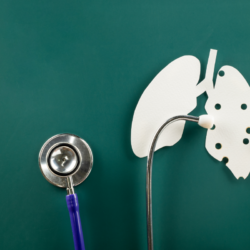Zoonoses are a group of infections that can be transmitted from animals to humans. Among these, salmonellosis is particularly noteworthy because of its frequency and the major health consequences it causes. These infections, caused by bacteria of the Salmonella genus, manifest themselves through a range of symptoms, from mild gastroenteritis to serious infections.
What infectious agent is responsible?
Salmonella are bacteria of the Salmonella genus, a group of Gram-negative bacilli in the Enterobacteriaceae family. Of the many varieties, the best known are Salmonella typhi, Salmonella typhimurium and Salmonella enteritidis. Salmonella typhi is transmitted exclusively between humans and therefore does not constitute a zoonosis. The other serovars, on the other hand, are transmitted from animals to humans, thus constituting zoonoses.
These bacteria are remarkably robust, surviving for several weeks in a dry environment and several months in water. They are frequently found in polluted aquatic environments, with contamination by the excrement of carrier animals playing a key role. Aquatic vertebrates, especially birds (such as anatidae) and turtles, are major vectors of salmonella.
Salmonella measure between 0.7 and 1.5 μm in diameter and 2 to 5 μm in length, often with a flagellum. Biochemically, they are motile, facultative aero-anaerobes and ferment glucose. They have lipopolysaccharide O somatic antigens and H flagellar antigens, which are crucial for their serological identification. Some hypervirulent strains can resist current vaccines, posing a major challenge for public health.
Somatic O antigens, present in the bacterial wall, are essential for the classification of serovars. There are 67 different types. The major O antigen characterises a group of Salmonella, while the minor O antigen is accessory. Loss of this antigen through mutation can lead to a reduction or total loss of the bacterium’s pathogenicity.
The H flagellar antigens, present in two different forms (phases), also help to distinguish serovars. Some strains have both phases simultaneously (diphasic), while others have only one (monophasic).
How does this disease manifest itself in animals?
Salmonellosis can infect virtually all animal species, including ruminants, poultry, pigs and new pets such as tortoises and reptiles. The geographical distribution of salmonellosis is worldwide, with a significant presence in various animal production systems. In France, surveillance networks such as RESSAB and RENESA show a decline in cases in adult cattle but a persistence in poultry.
Salmonellosis is mainly transmitted to animals through the ingestion of food or water contaminated with infected faeces. Salmonella multiply in the digestive tract and are excreted in large quantities, causing long-term contamination of the farm environment. Poultry are often asymptomatic carriers, but can sometimes present with diarrhoea followed by mortality of the young. In ruminants and pigs, the disease manifests itself as severe diarrhoea, fever, depression and sometimes abortions.
Certain strains of salmonella are specific to certain animal species: Salmonella Abortusequi in horses, S. Gallinarum-Pullorum in poultry, S. Choleraesuis in pigs, S. Dublin in cattle, and S. Abortusovis in sheep.
In addition to food contamination, salmonella can be spread by direct contact with infected animals or by ingestion of contaminated water. The resistance of salmonella in the external environment, particularly in contaminated soil and water, increases the risk of transmission.
Symptoms of salmonellosis in animals vary according to species and bacterial strain. In poultry, infections are often asymptomatic, but can sometimes cause diarrhoea and mortality in young birds. In ruminants and pigs, symptoms include severe diarrhoea, fever, depression and abortions. Infections can also cause septicaemia in young animals.
How is it transmitted?
Salmonellosis is transmitted mainly via the digestive tract. The main sources of contamination include the ingestion of raw or undercooked foods such as eggs, egg-based products, milk and dairy products, as well as meat and charcuterie products. In the workplace, people who come into contact with infected animals or their contaminated environment, such as farmers, vets and slaughterhouse workers, are particularly at risk.
In metropolitan France, around 6,500 cases of salmonellosis are diagnosed each year. The dose required to trigger an infection is generally in excess of 100,000 bacteria. Infants and young children are more susceptible, requiring less ingestion to contract the disease.
Foods of animal origin are often implicated in transmission. However, cases can also occur through direct contact with infected animals or ingestion of contaminated water. Human-to-human transmission is possible, particularly in environments where hygiene measures are inadequate.
The risk of salmonellosis transmission is particularly high in contexts where hygiene rules are not rigorously observed. This includes inappropriate food handling, inadequate food storage and failure to cook at-risk products sufficiently. Eggs, unpasteurised dairy products, raw or undercooked meat, and fruit and vegetables contaminated with animal excrement are common vectors of transmission.
Animal health and food professionals must be particularly vigilant. Farmers, vets, slaughterhouse workers and veterinary laboratory staff are exposed to an increased risk of contamination due to their frequent contact with infected animals or their contaminated environment.
What are the symptoms of this infection in humans?
In humans, salmonellosis mainly manifests itself as acute gastroenteritis. Symptoms generally appear between 12 and 72 hours after ingestion of the bacteria and include diarrhoea, abdominal pain, fever, nausea and sometimes vomiting. Diarrhoea can be bloody, particularly in infants, and can lead to severe dehydration.
Most cases are mild and resolve in a few days without specific treatment. However, in immunocompromised individuals, infants and the elderly, the infection can become serious, even fatal. Complications such as septicaemia, meningitis or abscesses can occur, requiring urgent medical attention.
Symptoms also include headaches, abdominal cramps and sometimes blurred vision. Massive contamination through ingestion of contaminated food is the main cause, with the bacteria penetrating the digestive tract and provoking an inflammatory intestinal reaction. Clinical signs may persist for several days, and medical supervision is recommended to avoid complications.
Salmonella infections can lead to a variety of clinical manifestations, depending on the bacterial strain and the host’s immune status. In healthy adults, symptoms are generally mild and resolve spontaneously. However, the elderly, infants, pregnant women and immunocompromised individuals are particularly vulnerable and may develop severe forms of the disease.
Severe diarrhoea can lead to rapid dehydration, requiring immediate rehydration to prevent complications. Dehydration is particularly dangerous in young children and the elderly. Vomiting and nausea can worsen the state of dehydration, making close medical supervision necessary.
Systemic infections, although rare, may occur. Sepsis is a serious complication that can lead to death if not treated promptly. Focal infections, such as meningitis or osteoarticular infections, can also develop in individuals at risk. These infections require specific and often prolonged medical treatment.
How is the infection diagnosed?
Diagnosis of salmonellosis is based primarily on stool analysis to detect the presence of Salmonella. Stool cultures are commonly used, inoculated on selective media such as Salmonella-Shigella agar, Hektoën agar or XLD agar. These media can be used to differentiate Salmonella colonies from other faecal bacteria.
Serotyping is also essential for identifying the specific serovars involved in the infection. In France, the serotypes S. Enteritidis and S. Typhimurium are the most common. Blood cultures can be used in cases of severe infection or in immunocompromised patients to detect possible septicaemia.
Clinical diagnosis is based on symptoms of acute gastroenteritis, fever and abdominal pain. In patients with severe symptoms or in high-risk groups, additional tests may be required to assess the spread of infection.
Laboratory tests are essential to confirm the presence of Salmonella and to determine the specific serovar responsible for the infection. Coproculture, which involves inoculating stool samples on selective media, is used to isolate and identify the bacteria.
Biochemical and serological analysis of suspect colonies confirms the identity of the bacteria isolated. Serotyping, based on the agglutination reaction of O and H antigens with specific sera, is crucial for identifying the Salmonella serovar. This information is important for epidemiological investigations and the implementation of appropriate control measures.
In severe or complicated cases, blood cultures may be taken to detect possible septicaemia. The differential diagnosis must include other causes of bacterial, viral or parasitic gastroenteritis. Symptoms of salmonellosis may resemble those of other gastrointestinal infections, such as shigellosis, campylobacteriosis or Escherichia coli infections.
What is the appropriate treatment?
Treatment for salmonellosis is mainly symptomatic. Rehydration compensates for fluid losses due to diarrhoea and vomiting. Healthcare professionals commonly use oral rehydration solutions, and in severe cases, they resort to rehydration by infusion.
Antibiotic therapy, which is often not recommended for uncomplicated cases, can prolong asymptomatic carriage of the bacteria. However, doctors do prescribe antibiotics for patients at risk, such as infants, the elderly or immunocompromised patients. Commonly used antibiotics include ciprofloxacin, azithromycin and ceftriaxone.
Serious complications can be prevented by close medical supervision and appropriate treatment of symptoms.
In mild cases, the treatment of salmonellosis consists mainly of relieving symptoms. Patients should be encouraged to drink plenty of fluids to avoid dehydration. Oral rehydration solutions, containing essential electrolytes, are particularly useful. Anti-diarrhoeal drugs should generally be avoided, as they can prolong the infection.
In the event of severe symptoms or complications, hospitalisation should be considered. Intravenous rehydration can be used to correct electrolyte imbalances and prevent severe dehydration. In these cases, close medical supervision is essential to assess the response to treatment and adjust care accordingly.
Antibiotic therapy is reserved for severe cases, immunocompromised patients and young children. The antibiotics of choice include ciprofloxacin, a fluoroquinolone, and azithromycin, a macrolide. Ceftriaxone, a third-generation cephalosporin, is also used for severe infections. However, the emergence of antibiotic-resistant strains of Salmonella is a growing concern, requiring ongoing monitoring and adjustments to treatment protocols.
What preventive measures are available?
The prevention of salmonellosis relies on a combination of hygiene and food safety measures at all levels of the production chain. Producers must check the sanitary quality of animal feed and water, and protect fields from contamination by animal excrement.
Food operators follow HACCP (Hazard Analysis Critical Control Points) principles to identify and control critical points in production. Employees receive training in good hygiene practices, and monitoring measures ensure food safety.
Consumers wash their hands before preparing meals, cook food sufficiently, especially meat, and avoid raw milk products for people who are sensitive. They keep eggs and egg-based products refrigerated and eat them quickly.
Collective prevention measures include monitoring farms and implementing vaccination programmes for animals. Farmers follow strict protocols for cleaning and disinfecting facilities to reduce the bacterial load. Controlling vectors such as insects and rodents also minimises the risk of contamination.
In the workplace, workers exposed to the risk of contamination receive training in preventive measures. The use of personal protective equipment, such as gloves and appropriate work clothing, is crucial. Workers have access to regular hand-washing facilities and separate changing rooms to avoid cross-contamination between work clothes and personal belongings.
Control measures in the event of infection on farms include isolation of sick animals and curative treatment. Access to contaminated sites is limited to essential professionals, and rigorous disinfection protocols are applied.
Some epidemiological data…
Salmonellosis is the second most common cause of food-borne gastrointestinal infections in Europe. In 2018, the health authorities recorded 91,857 confirmed cases of salmonellosis, representing a rate of 20.1 cases per 100,000 inhabitants. In France, experts estimate the incidence of human salmonellosis at around 307 cases per 100,000 inhabitants per year. Also in 2018, the authorities declared 1,630 cases of collective food poisoning, affecting 14,742 people, 777 of whom required hospitalisation and two of whom died.
The Enteritidis serotype is the most common, followed by the monophasic Typhimurium and Typhimurium variants. These three serotypes account for 61% of isolations in France. Major epidemics can occur, such as the one in the United States in 1994, when 224,000 people were affected by contaminated ice cream.
In Europe, infections by Salmonella bacteria have been falling steadily since 2001, reflecting the effectiveness of health safety policies in livestock farms and abattoirs.
The National Reference Centre for Escherichia coli, Shigella and Salmonella (CNR) at the Institut Pasteur plays a crucial role in the microbiological surveillance of human salmonellosis in France. In 2018, the CNR recorded between 10,000 and 11,000 Salmonella isolations from humans every year. Researchers differentiate these bacteria into more than 2,600 serotypes, with Enteritidis as the majority serotype, followed by the monophasic variant Typhimurium and Typhimurium.
Salmonellosis epidemics can have serious consequences. In 2019, in the Hauts-de-France region, the authorities identified 25 cases of salmonellosis caused by Salmonella Bovismorbificans. Investigations revealed that consumption of raw or undercooked horsemeat was the likely source of this epidemic.
Traceability investigations revealed a common supply circuit with a Belgian wholesaler, supplied by a slaughterhouse and meat cutting plant in Romania.
Measures to combat salmonella
The Anses is essential for monitoring contamination of animals, foodstuffs and the environment in farms, slaughterhouses and preparation plants. As part of official surveillance and the national reference mandate, Anses characterises the different strains of salmonella. It analyses their evolution through the Salmonella network . This network collects strains from animal, food and environmental sources.
It also participates in the investigation of outbreaks of human salmonellosis in collaboration with the Direction Générale de l’Alimentation, Santé Publique France and the Centre National de Référence des Escherichia coli, Shigella et Salmonella (ESS). The Anses carries out risk assessments throughout the food chain. It also identifies the most effective measures for reducing the risk of salmonellosis.
The WHO highlights the importance of food safety in ensuring a healthy and nutritious diet. It proposes policies and recommendations for the entire food chain, from production to consumption. This helps to strengthen food safety systems. It helps to set international standards, monitor diseases and train consumers and food handlers.
The WHO is strengthening laboratory capacity to monitor food pathogens such as Campylobacter and Salmonella. It promotes the monitoring of antimicrobial resistance. Together with the FAO, the WHO coordinates international efforts to detect and respond to food-borne disease outbreaks via the International Food Safety Authorities Network (INFOSAN).
Directive 2003/99/EC requires Member States to set up surveillance systems for certain zoonoses, including Salmonella. In France, the National Reference Centre for Salmonella (CNR) monitors human salmonellosis. To do this, it collects data on isolated strains and serotyping results. Officials from the DDecPP ( Departmental Directorates for Population Protection) carry out official controls. State-approved laboratories also carry out analyses.





